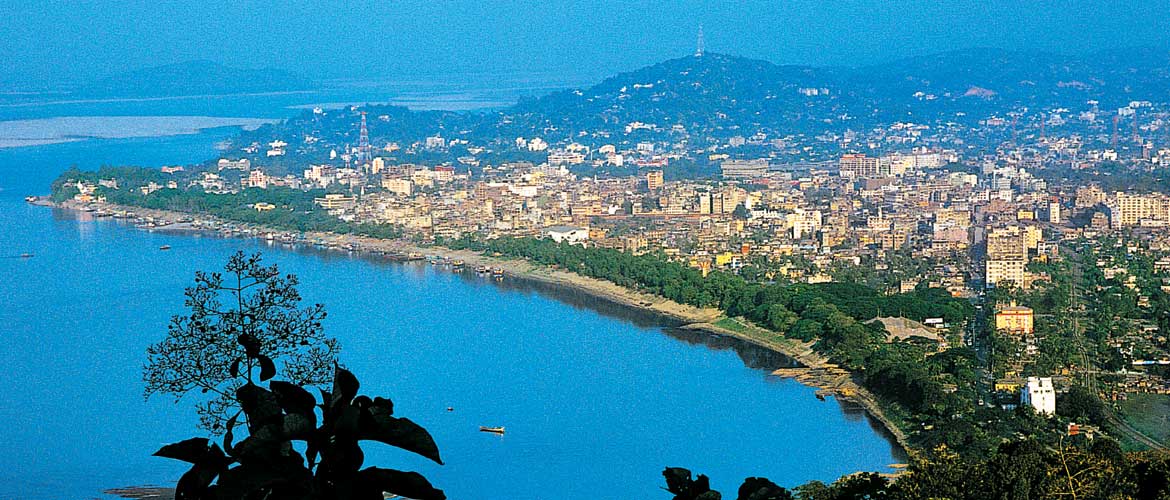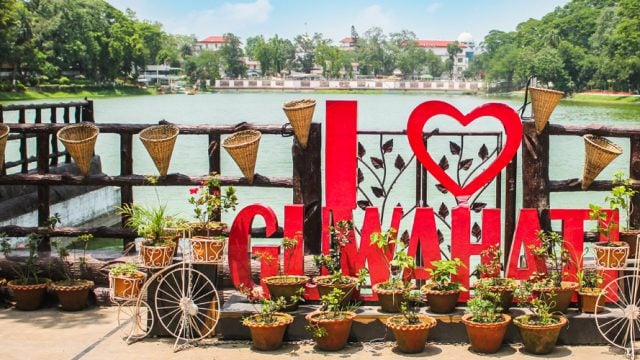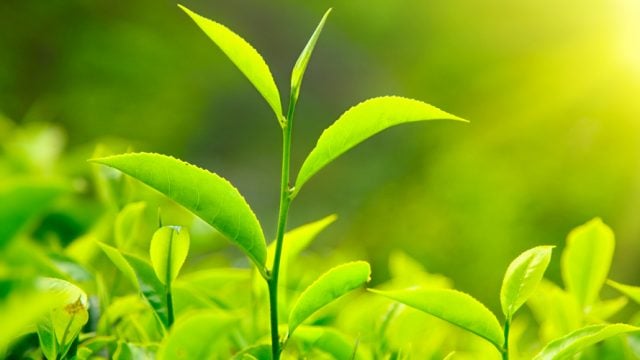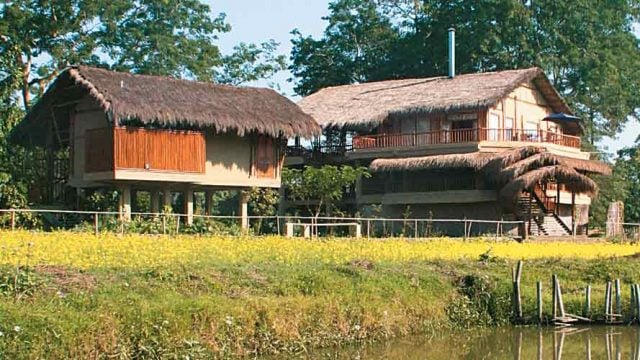Guwahati
Gateway to the Northeast – this is a fitting sobriquet for the city
Guwahati is well connected with the rest of the country by rail, air and road. The Lokapriya Gopinath Bordoloi International Airport is located at Borjhar, around 20km from the centre of the city.

There are two main railway stations – the Guwahati Junction, which lies in Paltan Bazaar and the Kamakhya Junction in Maligaon, located 10km to the northwest from the city centre. The Interstate Bus Terminus is located around 10km south from the city centre in Ahom Gaon.
The easiest mode of transport here are buses that ply all over the city with regular frequency. Autos are aplenty as well, but charge exorbitant sums of money and are best avoided.
Things to See & Do
Kamakhya Temple
For many visitors, Guwahati is synonymous with the famous Kamakhya Temple. Indeed, a trip to Guwahati cannot be considered complete without visiting the temple premises. To reach the sanctum sanctorum you will have to brave the relentless crowds of hawkers, devotees and beggars.
The concrete Kamakhya Mandir Road winds up the Nilachal Hill and leads you to the extremely crowded chowk, a little ahead of which is the parking area. A wide, crowded staircase, flanked by many shops and hawkers selling puja paraphernalia, leads you to the main gate of the temple. This initial overwhelming assortment of sights, sounds, smells and people will probably leave some visitors dazed and confused.
One of the 51 shaktipeeths of the country, the temple is the seat of the Goddess Kamakhya. According to legend, Lord Shiva, grief-stricken and enraged at the universe after his wife Sati’s self-immolation, rendered the tandava (dance of destruction) carrying her charred body in his arms, and destroyed everything that came in his way. Lord Vishnu, in an attempt to save the world, unleashed his sudarshan chakra and dismembered Sati’s body. Whichever spot a body part fell on became charged with primordial energy (shakti), and came to be known as a shaktipeeth (seat of shakti). This spot is said to lie deep inside the garbhagriha and remains covered in a red silk cloth.

The inscriptions on the walls of the Kamakhya complex date back to the 5th–6th century CE. However, the main temple was constructed by Koch king Nara Narayan in the 16th century CE. It is believed to be one of the earliest architectural constructions undertaken by the Koch kings.
The structures surrounding the shikhara look like minarets and are believed to have been inspired by Islamic architecture and are credited to the Kooch Bihar architectural style. The antarala (antechamber between garbhagriha and mandapa) of the temple has a simple, plain roof. The outer walls are decorated with sculptures. A small corridor leads to a small flight of steps, which descend into the garbha-griha. This dark, underground chamber shelters a rock covered with a red silk cloth symbolising the spot where Sati’s body part fell.
Tip It is best no to carry leather bags or purses inside the temple premises. Refrain from carrying cash and other valuables as you will be required to submit these outside. No shoes are allowed inside the temple
Where to Stay
Guwahati offers plenty of hotels across all budgets. Almost all have restaurants, bar, Internet and accept credit cards.
The new Radisson Blu Hotel (Tel: 0361-7100100; Tariff: ₹8,000–35,000) on NH37 in Gotanagar is the only five-star property here. The rooms and suites are stylish and comfortable and offer good views of the hills. Hotel Brahmaputra Ashok (Tel: 2602281- 84, 2602287-88; Tariff: ₹5,500–15,000) is a four-star property on MG Road, located by the banks of the River Brahmaputra.
Hotel Raj Mahal (Tel: 2549141-46, 2511602-04, Cell: 08486020037; Tariff: ₹4,000–12,000) in Paltan Bazaar and Hotel Viswaratna (Tel: 2607712–15, Cell: 09954130005; Tariff: ₹4,200–8,900) on AT Road have a spa and swimming pool. Pragati Manor (Tel: 2341261-63, Cell: 09678005102, 09954011800; Tariff: ₹4,500–9,000) on GS Road in Christian Basti is clean and serves good food. WHERE TO EAT
Driving through the city, you will notice plenty of bakeries. This seems to be the latest trend in Guwahati. If you wish to indulge in the same, then Loyan’s and Patisserie Opera are some of the well-known bakeries here.
It would be a shame to go back without trying the local cuisine, so try the Assamese fare served at Paradise Hotel or Khorikaa Restaurant, both local favourites. Naga Meez and Naga Kitchen are popular restaurants as well.
Those in the mood for Chinese food must look no further than Chinatown, Chung Fa and Confucius. JB’s, very popular with vegetarians, is a restaurant chain that serves Indian snacks. For north Indian food, you can also head to The Dhaba. Some restaurants such as Oregano and Terra Mayaa offer a mixed cuisine menu with Indian, Chinese and Continental dishes. For those only interested in Continental food, there are a spate of cafés, such as Mocha, Corner Café, Brown Bean Café and Café Coupa. Apart from all these options, you will also find the usual international fast food chains.

Manas National Park
A spectacular jungle and a very unique one, Manas National Park has the singular distinction of being a wildlife sanctuary, national park, biosphere hotspot, a Natural World Heritage Site, a Project Tiger and Project Elephant reserve and also one of the better known birding areas in the world.
The only unwanted title it has is a UNESCO World Heritage Site in Danger, following the Bodoland agitation through the 1980s and much of the 1990s, although thankfully, now matters have improved greatly because of local and government initiatives.
The core area of the Tiger Reserve spreads over 321sq km of the Manas National Park. The park altogether encompasses over 2,837sq km. In 2002, the Manas Park was designated as the core zone of the Buxa-Manas Elephant Reserve under Project Elephant. The forest, however, extends much further, into neighbouring Bhutan, where it is known as the Royal Manas Park. To the south of the park, NH31 adjoins Barpeta Road, where the Field Director’s office is located. It is from here that you get permits to enter the park in case you plan to stay at Mathanguri, where the Inspection Bungalow is located. Mathanguri is the point through which the River Manas enters India from its source in Bhutan. It is to the north of the park, next to the border with Bhutan.
Tourists pay their entry fee at the Bansbari Range Office, near the entry gate where an armed ranger joins them. There are no Forest Department jeeps or guides available for tourists, but private jeeps can be hired from near the Bansbari Range Office or at Barpeta Road. Permits to enter the park are also arranged from here.
◆ Entry Indians ₹50; Foreigners ₹500 (half day) Indians ₹200; Foreigners ₹2,000 (full day) Timings 7.30am–2.30pm Jeep hire ₹3,000 (4 pax, half day) ₹5,000 (4 pax, full day) Photography Indians ₹50; Foreigners ₹500 Videography Indians ₹500; Foreigners ₹1,000

Things to See & Do
Visitors to Manas can opt for a jeep safari; an elephant safari should not be missed. This can be coupled with plantation visits and jungle walks. One could also go river rafting on the Manas between Mathanguri and Bansbari. This expedition of about 20km is organised by the Forest Department and private operators as well.
Jeep Safaris
You can enter the park either in your own four-wheeler or in a hired one. In the distance, across the Manas river, loom the blue-purple hills of neighbouring Bhutan. The vegetation, so different from what is seen in the jungles of the plains, gives the forest a strange, exotic feel. Hornbills swoop across the skies; elephants forage silently at the edge of the trees; insects whirr in the evening. It’s classic tiger country, with dense undergrowth thick with moss and vines on which capped langurs caper, open grasses through which hog deer and cheetal stare, and a river as well as streams that provide watering holes in which enormous wild water buffaloes with metre-long horns wallow.
At night, the jeep lights make the forest seem even more mysterious, with trees rising in odd, twisted shapes from the road, branches leaning out and over and then rising silently above.
Elephant Rides
Don’t pass up the opportunity to take an elephant safari around Mathanguri, deep inside the park, where the government maintains its Inspection Bungalow at a spectacular point overlooking the rushing river and the cloudy Bhutanese hills. Contact the Bansbari Range Office for booking details.
◆ Fee Indians ₹500; Foreigners ₹1,550 Timings 6.00am & 7.00am

Where to Stay & Eat
There are limited stay options in Manas. The government-run Forest Lodge (Cell: 09435124949; Tariff: ₹1,200) is 22km inside the park at Mathanguri, by the Manas River. It has six double rooms and a canteen. You have to pay for diesel to help run the generator. However, it is the most picturesque place to stay. The Bansbari Lodge (Guwahati Tel: 0361- 2667871-73, Cell: 09207042330/ 31; Tariff: ₹2,450) is a private hotel right outside the park gate. It has 16 double rooms with hot and cold water and room service. Meals are provided at extra cost (breakfast for ₹158 per head, lunch/ dinner ₹289 per head). Indian, Chinese and Continental cuisine is served. The lodge organises dance performances in the evenings on request and also offers transfers from Guwahati. Birina Tourist Lodge (Tariff: ₹2,200–2,500) has a superb location near the Fatehabad Tea Estate, close to the entrance of the Bansbari Range. The rooms are large, clean and airy with dressing rooms and attached modern bathrooms. The Lodge arranges jungle safaris, birdwatching treks, bonfire and village tours. They have an open-air theatre for cultural programmes. On the eastern edge of the national park lies the Eco Camp Cottages (Cell: 09864034614, 09435875539; Tariff: 2,000), which offer river rafting and jungle safaris for guests.
Location On the India-Bhutan border, on the north bank of the River Brahmaputra, 146km NW of Guwahati
Kaziranga National Park
An inexplicable sense of excitement envelopes you as you head towards one of the most popular habitats of the great Indian rhinoceros, the Kaziranga National Park. The anticipation of spotting this great animal up close enlivens the otherwise peaceful drive to the park from Jorhat on the NH37. The highway is flanked by dense forests on one side and verdant tea plantations on the other. Kohora is the base most visitors make a beeline towards, but even before one reaches this gateway into Kaziranga, it becomes clear that this entire area is rhino territory. In fact, it is quite possible to spot a stray rhino grazing on the side of the road even before entering the park limits.

The great Indian rhinoceros may be the greatest attraction of Kaziranga but it also has the highest density of tigers amongst all protected areas of the world. Unlike the rhino, however, the Royal Bengal tiger is harder to spot amidst the thick undergrowth. Along with these two prized animals, the national park is also home to the elephant, Indian bison, sambar, leopard, hog deer, sloth bear and hoolock gibbon. Avian species found here include pelican, rose-ringed parakeet, serpent eagle, Bengal florican, bar-headed geese, whistling teal and red jungle fowl.
Orientation
Kaziranga spreads over 480sq km; it stretches east to west with the Brahmaputra as its northern boundary, and is fringed by the Karbi Hills in the south. The south of the park is very easily accessible as NH37 runs right through it. This area has many villages, fields and vast tracts of tea estates; in fact, all the tourist entries into the park are past villages and fields. Kaziranga National Park is demarcated into three main tourist ranges – Kohora, Baghori and Agaratoli. All these routes wind through the southern sector of the park, which teems with wildlife. Kohora (Tel: 03776-262428) is the central range, and most tourist facilities and park entry formalities are based here. Early morning elephant rides begin from Kohora every tourist season (these have recently been introduced at Baghori as well), offering people a close-up feel of the grassland at dawn – rhino sightings are almost assured on these rides. Forest Department jeeps are hard to come by for a jungle safari so it is advisable to hire a vehicle from the chowk at Kohora. This might prove to be cheaper than hiring one from your hotel. The latter’s charges will be around ₹4,200 for the whole day or ₹1,900 for Kohora, ₹2,100 for Baghori, ₹2,300 for Agaratoli and ₹500–600 to go to Panbari.

Park Entry Indians ₹50; Foreigners ₹500 Timings 7.30–9.30am & 2.00–3.00pm Jeep Safari ₹1,500–2,500 + Road toll ₹300 + Guard fee ₹100 per vehicle Photography Indians ₹50; Foreigners ₹500 Videography Indians ₹500; Foreigners ₹1,000 Elephant Safari Indians ₹450; Foreigners ₹1,000 + Entry fee ₹50/ ₹500 +Toll fee ₹300 + Guard fee ₹25 per person
You are not allowed to travel on foot in Kaziranga. Guides can also be hired from established hotels and they usually carry binoculars. In any case, it is best to have your own. It’s also important to have a personal survival kit, comprising a torch, medicines and toiletries
Things to See & Do
There are three tourist routes that you can opt for inside Kaziranga. Both jeep and elephant safaris are possible here.
Safaris
The jeep and elephant safaris are a must in Kaziranga. In the right season, you can spot many animals in just two days. As Forest Department vehicles are generally not available for tourists, jeeps can be hired at the Kohora Chowk or arranged through your hotel. Safari timings are monitored strictly by the Forest Department.
Birdwatching
A lesser-known fact about Kaziranga National Park is that it is also a birdwatcher’s paradise. It is second only to Corbett National Park in the diversity of bird population that is found here.
There are over 450 species of birds here, with the usual wetland resident and migratory varieties. The endangered Bengal florican, the pied hornbill, raptor and owl species can all be sighted in the park.

Where to Stay & Eat
A little beyond Kohora lies the Wild Grass Lodge (Tel: 03776-262085, Cell: 09954416945; Tariff: ₹950–2,450), Kaziranga’s most well-known hotel. Set in a large wooded estate, this is an elegant, serene and relaxing place surrounded by greenery. Once you get there, your itinerary is taken care of.
Kohora has varied stay options, from tourist lodges to private hotels. Assam Tourism’s Aranya Tourist Lodge (Tel: 262429; Tariff: ₹1,500–3,763) is about 3km from the park. The lodge arranges safaris too. Bonani Lodge (Tel: 262423; Tariff: ₹800–1,000) is a charming old-world option with basic infrastructure. Dhanshree Resort (Tel: 262501; Tariff: ₹1,405–2,943) has good ambience and views.
Assam Tourism also has Jupuri Ghar (Cell: 09435196377; Tariff: ₹2,500), Bonoshree Lodge (Tel: 262423; Tariff: ₹600); and Kunjaban Lodge (Tel: 262423; Tariff: ₹150 per bed).
IORA The Retreat (Guwahati Reservations Tel: 0361-2206666/ 789, Cell: 09957193550; Tariff: ₹2,950–14,000) has all facilities. Hotel Bonhabi (Cell: 09435504268; Tariff: ₹2,530–2,875) is located a kilometre away from the park.
Near the Bagori Police Outpost lies Diphlu River Lodge (Cell: 09207-042330/ 31; Tariff: ₹9,000 per person, with meals) by the picturesque Diphlu river. The rooms are spacious and comfortable. The food that is served here includes Chinese, Assamese and north Indian.
Infinity Resorts (Gurgaon Reservations Cell: 09650193664/ 66; Tariff: ₹6,000) is 7km from the park. Agoratoli Eco-tourism Resort (Cell: 09435110838, 09706010838; Tariff: ₹2,890–4,190, tents ₹2,490) near the Agoratoli Range has several cottages and tents.

Other options include Hotel Prayag Emerald (Cell: 09577916619; Tariff: ₹3,000–4,200) in Bogoriguri Tiniali and Kaziranga Florican Lodge (Cell: 09954246816, 09435250124; Tariff: ₹1,500–2,400) in Kohora; 09707865842; Tariff: ₹990–1,550) in Bogorijuri.
All the hotels listed above have their own restaurants.
Location This national park is spread over Golaghat, Nagaon and Sonitpur districts, 115km W of Jorhat, 193km NE of Guwahati
Dibrugarh
Situated on the northern-most tip of Assam, Dibrugarh is India’s original tea country. Acres of lush tea estates, some even dating back to the British era, frame the backdrop of this small town, set on the banks of the formidable Brahmaputra. About 450km east of Guwahati, Dibrugarh is easily the most important town in the upper reaches of the Brahmaputra Valley.
Dibrugarh acts as the perfect gateway to Assam’s tea districts. The districts of Dibrugarh, Tinsukia and Sivasagar collectively account for 50 per cent of India’s Assamese tea crop.
Dibrugarh is serviced by the Mohanbari Airport, around 15km away from the city centre. There are two train stations in the city, Dibrugarh Town and New Dibrugarh Railway Station. The latter is the biggest railway station in the entire Northeast. Buses, cycle rickshaws and shared auto rickshaws are the main modes of transport within the city.
Things to See & Do
Assam’s original tea city, Dibrugarh has some great experiences in store for visitors, be it a village walk, tea plantation visit or birdwatching in a reserve forest.
Tea Holiday
One of the great pleasures of visiting Dibrugarh is in getting a chance to live the high life of a tea estate manager. Picture the setting – a heritage bungalow amidst an expansive emerald green tea estate, stretching as far as the eyes can see. Watch a Bihu performance in the evening, sip endless cups of Assamese tea, read a book and then unwind. This experience can be enjoyed at Dibrugarh, courtesy Purvi Discovery – a travel agency run by the Jalan Group.
One of the oldest tea growing families in Assam, the Jalans have recently converted a few of their manager’s bungalows into guest-houses. Mancotta Heritage Chang Bungalow and Chowkidinghee Heritage Chang Bungalow, their two properties in Dibrugarh, are open to guests all year round. A stable of over a dozen thoroughbreds offer riding as well.
The bungalows gives you an idea of what life was like a century ago. Talking about architecture, there is an amalgamation of Assamese and colonial influence. The most well-thought out aspect of the cottages, is the huge size of windows, each one of them looking out to beautiful sceneries. Those who wish to just relax will find this the most perfect retreat. For those looking for a more packed itinerary, Purvi Discovery has plenty of activities planned around the estate.
Where to Stay & Eat
Dibrugarh Club House (Cell: 09706 054107; Tariff: ₹1,999–4,999) on AT Road is one of the best places to stay here. Other options on AT Road include Hotel Devika (Tel: 0373-2325956, Cell: 07896 636157; Tariff: ₹970–1,910); and Hotel Rajawas (Tel: 2323307, Cell: 094010 30551; Tariff: ₹1,400–4,250) .
Mancotta Heritage Chang Bungalow (Tel: 230110, 230035; Tariff: ₹7,500– 8,500) and the Chowkidinghee Heritage Chang Bungalow (Tel: 230110, 230035; Tariff: ₹7,500) are located in the midst of a tea garden. Bookings can also be done through Help Tourism (Kolkata Tel: 033-24550917, 24549719; helptourism.net).
Hotels will usually have their own restaurants. The Dibrugarh Club House has the best eatery in town. Hotel Natraj is also quite popular. KF is a new eatery in Thana Chariali. Nearby are Surbhi and Flavours, both local favourites.
Location 443km NE of Guwahati
Fast Facts
When to go November–February. It rains heavily from July–August
Tourist offices
Directorate of Tourism, Govt of Assam, Station Road, Guwahati, Tel: 0361-2547102, 2544475 assamtourism.gov.in
Assam Tourism Development Corporation, Asom Paryatan Bhawan, AK Azad Road, Paltan Bazaar
Guwahati, Tel: 2633654, 2738620, assamtourismonline.com
Field Director, Manas National Park, Barpeta Road, Tel: 03666-261413
DFO, Forest Office Bokaghat, Tel: 037776-268007
STD code Guwahati 0361
Getting There
Air Guwahati’s Lokpriya Gopinath Bordoloi International Airport located at Borjhar (25km/ 30–45mins/ ₹600 for a trip) is connected with regular flights by Air India, Jet Airways, Indigo, etc, to other cities. There are flights to Silchar, Dibrugarh, Jorhat and Lilabari within the state and to Agartala, Aizawl, Dimapur, Imphal and Bagdogra in the Northeast
Rail Guwahati Junction, the major railway station of Guwahati, and the Kamakhya Junction are connected to the major cities of the country. To name a few, Dibrugarh Rajdhani Express, Brahmaputra Mail, LTT-Kamakhya Express, Guwahati Express, Kamrup, Saraighat and Kanchanjanga Express connect Guwahati with cities in India. Taxis and auto-rickshaws are available outside the station. There is also a good network of city buses
Road NH31 connects the city to the rest of the country while NH37 connects Guwahati with almost all major cities of the state Bus Assam State Transport Corporation (ASTC) operates buses to various cities in the state. From Paltan Bazaar Bus Stand (Cell: 09957563033) there are connections to many destinations in the Northeast and West Bengal. The ISBT Guwahati (Cell: 09401727007) offers services to neighbouring states. Private Deluxe services are also available
Guwahati
Dibrugarh
Kaziranga National Park





